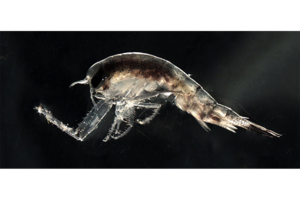In Arctic winter, 'werewolves of the deep' hunt by moonlight
Moonlight drives arctic zooplankton migrations during the dark, cold winter, researchers say.

Themisto libellula, an amphipod crustacean, is probably one of the werewolves of the Arctic, scientists say. The tiny animal is a predatory hunter of copepods such as Calanus finmarchius, one of the most common Arctic zooplankton.
Courtesy of Daniel Vogedes (The Arctic University of Norway, UiT)
Far north in the Arctic, winter means darkness. The sun barely rises over the horizon, or not at all, for months.
Scientists long thought that the marine animals, particularly tiny organisms called zooplankton, weren't moving around much when there was no sunlight. But research published in September 2015 found that ocean life is remarkably active through the cold, dark Arctic winter.
And now they have an explanation. When the sun disappears, the animals move around by the light of the moon, according to a new study published Thursday in the journal Current Biology.
During the other three seasons, zooplankton migrate from the surface of the sea down into the depths each day in what is called diel vertical migration.
When the sun rises, the tiny organisms wriggle down some 50 meters, or 164 feet. When the sun sets, they come back up.
Scientists found that without the sun, zooplankton migrate when the moon rises and sets. This happens across the whole polar region, scientists say.
And the lunar cycle is distinct from the solar. A lunar day is 24.8 hours, not 24 like a solar day. When the moon begins to dominate around the end of November, the animals' migrations follow the lunar cycle.
"The moon effectively takes over from the sun," study lead author and marine ecologist Kim Last tells The Christian Science Monitor in an interview. "For at least two months, the moon is dominant."
'Werewolves of the deep'
Zooplankton's vertical migrations are driven by their spot at the base of the Arctic food chain.
"These animals are migrating for a reason," Dr. Last says. "They're not just migrating for fun, because it's costly."
"If you're just a small little copepod, to migrate tens of meters costs a lot," in terms of energy, he says. "So they're running away from something pretty scary."
Last explains that the tiny marine organisms are moving away from predators that hunt near the surface of the ocean where they can see prey more easily.
"There are probably werewolves in these waters" that hunt the zooplankton by the light of the moon, Last said in a video news abstract. Previous research shows that "moonlight provides enough light for these werewolves of the deep to actually be out there hunting," he said.
Those predators chase the little organisms down into the depths, away from the moonlight-illuminated waters.
Zooplankton, carbon and the changing climate
Zooplankton play an important role in the ocean's carbon cycling. The animals feed on phytoplankton, microscopic plants living near the ocean's surface that consume carbon dioxide during photosynthesis. Then, the zooplankton's vertical migrations move that carbon down into the depths.
As the Arctic changes dramatically with warming global temperatures, other systems, like these migrations, could change.
Sea ice in the Arctic is melting rapidly and that could change the way sunlight and moonlight affect zooplankton movements, which in turn could influence the way the food chain works among all Arctic animals.
Changes in the zooplankton's behavior could affect many more things in turn, so this research will help scientists study the changes happening in the Arctic.
"Having an understanding of what they do will allow us to make much better predictions of what might happen in the future," Last says.


